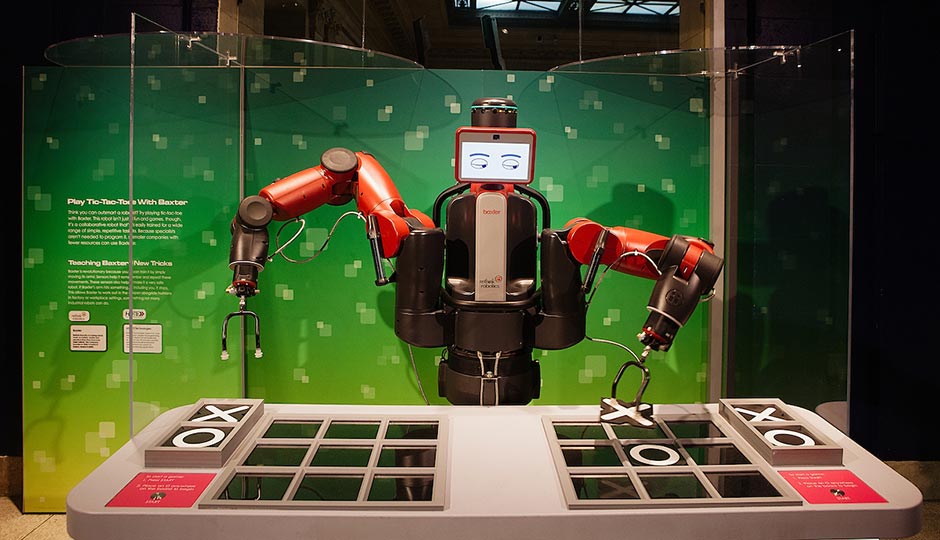The Robots Are Coming! Inside the Franklin Institute’s “Robot Revolution”

Sly guy Baxter, making his move. Photo by Daryl Peveto
Robots are like those creepy clowns that have been popping up everywhere, only more scientific. They’re at once attractive and repulsive: sort of human, clearly not really human, with an undercurrent of someday-we’ll-take-over-your-world. I got to write about robots for Philly Mag’s September issue, and on Thursday I got to attend a preview of the Franklin Institute’s new “Robot Revolution” exhibit, which opens this Saturday and runs through April 2nd.
It’s terrific. It’s fascinating. It has all kinds of robots: robots you can play blackjack against, robots you can make faces at (they make the same faces back at you), robots who solve Rubik’s Cubes, robots playing soccer on a miniature soccer field. There are furry robots (Paro, modeled after a baby seal), bionic robots (an exoskeleton that lets paralyzed people walk), modular “Cubelet” robots you assemble yourself. You’ll see robots that can ride bicycles, climb walls, go up stairs, see around corners and see in the dark. You’ll see an interactive drone show!
Some of the robots are adorable — for instance, the “swarm robots,” inspired by swarms of insects and intended to work in groups. Push a button and they flock together; push another and they fall into single-file line. There’s a simulation of a self-driving Google Car that you can sit in. There’s a robot used by the military and police to explore dangerous environments before humans move in. Maybe you can move it up the ramp with the joystick; when I tried, it just kept going in circles, which probably explains the trouble I have when I parallel-park. Some of the robots are weird, like EMYS, “designed to explore how we respond to robots that show emotion.” When you push one button, EMYS makes a Happy face; when you push others, he — she — it is Disgusted, or Angry, or Sad. That one still needs a little work.
As high-tech as these robots appear, a lot of them rely on attributes taken straight from nature, as the exhibits explain. A Festo gripper was inspired by an elephant’s trunk. The RisE robot, which can climb trees, has “feet” modeled after those of a gecko. The RHex, designed to travel over rough ground, is based on the way cockroaches and beetles move, and it really looks, and moves, like a giant roly-poly bug. The most fun of all might be the Robotis-Mini, a one-foot-tall ’bot that will wave to you, drop for pushups, do a handstand, execute karate kicks and spread-eagle like a hockey goalie, all at your command.
I was happy to see my old friend Baxter, a shiny red robot I first encountered at Penn, where he was slapping high-fives. Here, he’s playing tic-tac-toe against all comers, two at a time. I looked right into his shifty little eyes and played an O to start our game. He laid down an X. I played another O. He put an X down — right on top of my O. “Baxter, you’re cheating!” I told him, shocked. I think he might have remembered me.
I beat him anyway. One point for humankind!
“Robot Revolution” tickets are $29.95 per adult and $25.95 per child, which includes general admission to the Franklin Institute; the exhibit is free to Institute members through December 3rd. This Saturday only, general admission covers a day of free robot-themed events throughout the Institute, including the daylong “Battle of the ’Bots” for the coveted Franklin Cup, the debut of the new Drone Zone drone show, a robot name generator, scribblebots, ozobots and more.


